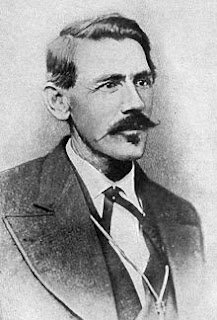Brent Towns (who also writes as B. S. Dunn, Jake Henry, and Sam Clancy) tells me a
favourite of his own novels is his first Black Horse Western FURY AT BENT FORK – credited to B.S.
Dunn - ‘because I felt a great sense of achievement.’ (Something I’m sure all us
published novelists feel about their debut novel.)
Four big ranchers, known as the Committee, seek to dominate their
section of Colorado. They hire a pack of gunmen under Slade Johnson, but
smaller ranchers resist – led by young Chad Hunter. Chad’s also being
pursued by a cold-blooded murderer just escaped from prison.
‘It became known as the Stone Creek
Valley War and for a time, the valley ran red with the blood of innocents and
killers alike.’
Probably the two most famous of these Range Wars were the ‘Lincoln
County War’ and the ‘Johnson County War.’ I’ll blog about the latter another
day.
Actually the Lincoln County War in New Mexico of the late 1870s saw small ranchers such as
JOHN TUNSTALL, an Englishman originally from London,
aligned with cattle baron JOHN CHISUM
and local lawyer ALEXANDER McSWEEN.
Their main beef (pardon the pun) was against two businessmen running a
powerful conglomerate based in the town of Lincoln. This pair of Irishmen – J.
J. DOLAN and JOHN RILEY – owned a big general store called ‘The House.’ They also controlled most government contracts
for supplying beef to army posts and Indian reservations. On top of that they
had the law, fronted by Lincoln County Sheriff WILLIAM BRADY, in their pocket.
William Brady in 1872
The other faction didn’t see why Dolan and Riley should have a monopoly
on either trade in Lincoln or beef contracts.
Tension between the two sides exploded into violence in February 1878.
Brady sent a posse to seize some of Tunstall’s horses as payment for an
outstanding debt. They encountered Tunstall out on the range. When Tunstall
refused to hand the horses over, Deputy Sheriff WILLIAM MORTON shot him in the head.
Men in the employ of Tunstall and Chisum formed a posse of their own –
nicknamed The Regulators – and set out to get their revenge. Which is when The
Lincoln County War enters the realms of legend: one of these ‘Regulators’ was a
slight young man – probably in his early 20s - called HENRY ANTRIM or HENRY
McCARTY. It’s wrongly claimed he was born William Bonney, but history remembers
him as BILLY THE KID.
https://andrewmcbrideauthor.blogspot.com/2017/06/the-arizona-kid-by-andrew-mcbride.html
To briefly summarise the violence that ensued: The Regulators captured
Morton and another of his posse and shot them. In an even more audacious move
they ambushed Sheriff Brady as he walked the streets of Lincoln. Brady and
another deputy were felled by a hail of bullets from cover.
Events culminated in a 5-day siege (the so-called ‘Battle of Lincoln’) in
July 1878. The Regulators were cornered in McSween’s home in Lincoln by
supporters of ‘The House.’ Despite desultory exchanges of gunfire there were no
casualties until the fifth day, when McSween’s house was fired. The besieged
fled the burning building, braving a blizzard of gunfire that cut down McSween.
In total perhaps seven men (two of the ‘House’ faction, and five Regulators)
were killed. The remaining Regulators scattered.
The Lincoln County Cattle War was over and ‘Billy the Kid’s’ side had convincingly
lost.
Legend attributes the prominent role in these actions to Billy and
claims he did most of the killing. In reality he was only one of a number of
participants. He only seems to have taken over as leader during the ‘Battle of
Lincoln.’
Most fictional depictions of the Lincoln County War show teenage Billy
as looking up to Tunstall as a wise elder, a kindly uncle if not father figure.
As it happens Tunstall at the time of his death was 24, possibly only two years
older than Billy.
The FURY AT BENT FORK scenario
of small ranchers/homesteaders versus big ranchers naturally brings to mind
SHANE.
Alan Ladd in ‘Shane’ (1953)
The hero being unjustly convicted of cattle rustling, when his real
crime was standing up to a powerful conglomerate, made me think of BROKEN
LANCE.
Richard Widmark, Spencer Tracy and Robert Wagner in ‘Broken Lance’ (1954)
Reviewer for FURY AT BENT FORK:
‘Wow! Great book.’







No comments:
Post a Comment